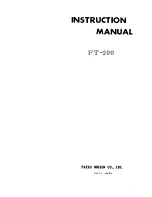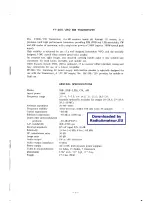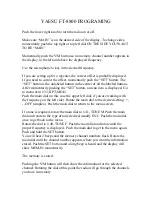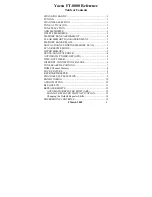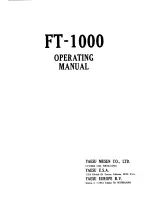
Document 2.4.126, Revision 4
October 2017
15
Three-Phase Padmounted Distribution Transformers
The following operating instructions and
descriptions of switching and fusing devices are
intended to be a general guide for operation of
Howard three-phase padmounted transformers in
normal environments. Although efforts have been
made to ensure accuracy and completeness, these
instructions and descriptions do not address every
conceivable application or circumstance that might
be encountered. Personnel should read and comply
with any safety and instructional labels that might
accompany an accessory device.
Many of the accessory devices described below are
optional and may not be present in any particular
transformer design. The inclusion of particular
accessory devices in any transformer design is
governed by industry standards and by individual
customer specifications.
Tap Changer
The de-energized (no-load) tap changer may be used
to adjust the voltage ratio of a transformer while it
is de-energized. It is intended to allow adjustment of
the output (secondary) voltage to the rated value. Do
not use the tap changer to raise or lower the output
voltage to any voltage other than that indicated
on the transformer nameplate. If the tap changer
is set to provide an output voltage different from
rated secondary voltage, core saturation may occur,
resulting in a high noise level and high core loss.
SECTION 5: OPERATION OF SWITCHING AND PROTECTIVE DEVICES
DANGER
FAILURE TO FOLLOW THE INSTRUCTIONS
BELOW WILL RESULT IN DEATH OR SERIOUS
INJURY, AND DAMAGE TO THE EQUIPMENT.
• Do not operate load-break equipment if a
fault condition is suspected.
• Use a live-line tool (hot stick or shotgun
stick) to operate transformer load-break
equipment.
• After operating transformer loadbreak
equipment, check that voltages at
transformer terminals are the expected
values. Checking voltages verifies that
loadbreak equipment operated properly
and that electrical circuit conditions are
as expected.
• Before servicing the transformer,
ALWAYS de-energize the transformer
from a remote upstream source and
then proceed to ground all primary
and secondary transformer terminals
following industry-accepted safe
grounding practices. Grounding secondary
terminals protects against situations
such as a standby generator energizing
transformer from the secondary circuit.
• Follow industry-accepted safety practices.
Utilize personal protective equipment
when working with this equipment.
DANGER
FAILURE TO FOLLOW THE INSTRUCTIONS
BELOW WILL RESULT IN DEATH OR SERIOUS
PERSONAL INJURY, AND DAMAGE TO THE
EQUIPMENT.
• Do not operate a de-energized (no-load)
tap changer unless the transformer is
totally de-energized.
• Do not re-energize the transformer unless
the tap changer handle is locked into
position.
DANGER
FAILURE TO FOLLOW THE INSTRUCTIONS BELOW
WILL RESULT IN DEATH OR SERIOUS INJURY,
AND DAMAGE TO THE EQUIPMENT.
• Do not operate fluid-immersed load-break
fusing and switching devices when the
insulating fluid temperature is below the
following limits:
- 20°C (-4°F) for conventional
transformer oil
-0°C (32°F) for R-Temp fluid
-10°C (14°F) for FR3 fluid































